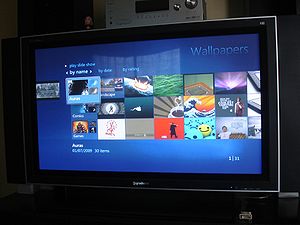
Image via Wikipedia
(ARA) – Everyone, it seems, is eager for 3-D. It’s a fad that’s had its heyday more than once in pop culture, but this time all signs point to 3-D finding staying power in American theaters and homes. If you have any doubt that 3-D is hot, consider the fact that more than 100 movies – from children’s animated films to big-budget sci-fi offerings – were released in 3-D in theaters and on DVD in 2009 and 2010. And weigh the fact that nearly every major TV-maker has at least one 3-D set on the market.
In fact, manufacturers are banking that Americans will embrace 3-D in their home viewing experience just as they did flat screens, high definition and Internet access. A 3-D TV may well be the high-tech investment your family opts for in 2011, but before you buy, here are a few things you should know – and consider – about 3-D television:
Cost considerations
As with any new technology, 3-D TVs appeared on the market at higher prices than what you would pay for a comparable quality 2-D high definition set. While you could easily find large flat-screens for $1,000 or less in 2010, most 3-D units sold for upward of $2,000. Prices are coming down, however, and industry watchers predict they’ll drop lower this year as the technology improves and manufacturers try to stimulate consumer interest.
Many manufacturers have announced lower prices on their 3-D sets for 2011. “Prices for 3-D TVs will definitely go down this year as our production costs have been dropping with improved technology,” says Skott Ahn, LG’s chief technology officer, who also predicts that 3-D technology will become mainstream in a few years.
What this means for you, the consumer, is that this year you can probably pick up a quality 3-D TV for about what you would expect to pay for a good 2-D set.
Current 3-D TV technology requires viewers to wear a pair of 3-D glasses to enjoy the technology. Most 3-D TVs use active 3-D glasses which contain a power source within the glasses. Expect to pay around $100 to $200 per pair of active 3-D glasses. Some 3-D TV manufacturers are beginning to offer a passive 3-D technology. Passive 3-D glasses do not require a power source to view 3-D content, so they are lighter and cheaper.
Despite some reports that “glasses-free” 3-D TV is set to come soon, most consumer electronic experts agree that the technology is several years away from being available to consumers.
Viewing angle caveats
If you’ve ever tried to watch a big game or movie on a 2-D LCD or LED TV with a large group of people, you’ve probably experienced the issue of limited viewing angle options. Because of the technology used to put the image on the screen, LCD and LED TVs don’t always offer a good image from every viewing angle. The issue is even more relevant for 3-D TVs, according to Best-3DTVs.com.
That’s because 3-D TVs share the same viewing angle issues as some 2-D flat screens, but with the added challenge that 3-D glasses can also block light from the screen, lowering brightness and contrast. If you’re also viewing the screen from an angle, all these factors can lead to a “very underwhelming 3-D viewing experience,” the website points out.
“Most industry experts argue that 3-D technology actually increases the viewing angle problem,” says Jim Wohlford, vice president of Sanus, makers of TV mounts and accessories. “Early 3-D reviews indicate a ghosting effect around objects on the screen when viewed from an angle.”
Fortunately, wall-mounting on a full-motion mount, which can resolve viewing angle issues for 2-D flat screens, is a good option for 3-D TVs as well. Products like the VisionMount VLF311 Super Slim Full-Motion Mount allow you to maintain the sleek, low profile look of a flat-screen while still having the ability to move the set to whatever position or angle is best for your viewing needs.
“By placing a TV on a full-motion mount, you can be sure you can always achieve the optimal viewing angle from any seat in the room,” Wohlford says. “Full-motion mounts are available to accommodate all sizes of TVs, are easy to install and simple to use. They apply a low-tech, time-honored solution to one of the most common problems of our favorite high-tech toys.”


